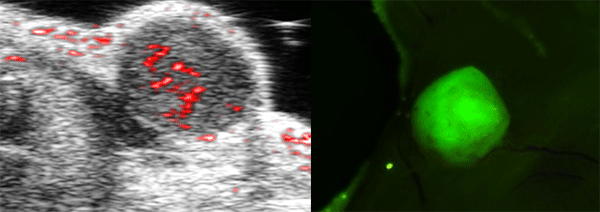
Photoacoustic (left) and fluorescence (right) imaging of HER2-overexpressing tumors in a mouse model of human breast cancer. Red and green colors represent BHQ3 and fluorescein, respectively.
Molecular imaging probes that target specific biomarkers, such as cellular receptors, can facilitate cancer diagnosis and surgical guidance. Combining probes that are visualized using different imaging modalities (fluorescence plus photoacoustic imaging) is particularly beneficial because it enables real-time, sensitive tumor detection in deeper tissue layers, based on multiple biomarkers.
Canadian molecular imaging scientist Dr. Ralph S. DaCosta and colleagues at the Princess Margaret Cancer Centre (University Health Network) recently published a study in Molecular Imaging describing their development of a dual-modality imaging probe. This probe targets human epidermal growth factor receptor 2 (HER2) for visualizing its differential expression levels in an animal model of breast cancer. Trastuzumab, an antibody against HER2 that is cytotoxic to HER2-overexpressing tumor cells, was labelled with Black Hole Quencher 3 (BHQ3) and Fluorescein for HER2 photoacoustic and fluorescence imaging, respectively.
The Toronto-based researchers found that this dual-labelled probe exhibited high tumor specificity using photoacoustic imaging, with more than twice the signal intensity for HER2 overexpressing tumors versus low HER2 expressing tumors. Fluorescence imaging of the dual-labelled probe enabled sub-millimeter tumor detection and assessment of positive surgical margins in the animal model.
This new technique holds promise for future clinical studies in breast cancer patients to improve early diagnosis and guide surgical resection at the molecular level. Early diagnosis increases survival rates and minimizes the need for unnecessary surgery, such as lymph node removal and repeat breast surgery due to incomplete removal of tumor cells during the first surgery. According to Dr. DaCosta, “Despite significant progress in the diagnosis and treatment of breast cancer, the need remains for better approaches and tools that will have less of a negative effect on a woman’s body. While the regulatory approval pathways for clinical use of such novel imaging agents can be lengthy, if successful this approach could in time help women with breast cancer live longer, healthier lives.”
Preclinical publication: Dual In Vivo Photoacoustic and Fluorescence Imaging of HER2 Expression in Breast Tumors for Diagnosis, Margin Assessment, and Surgical Guidance
